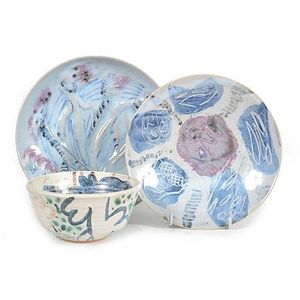Antique Victorian Ball Vases with Blue Glass Rims
You must be a subscriber, and be logged in to view price and dealer details.
Subscribe Now to view actual auction price for this item
When you subscribe, you have the option of setting the currency in which to display prices to $Au, $US, $NZ or Stg.
- Victorian Period - The Victorian period of furniture and decorative arts design covers the reign of Queen Victoria from 1837 to 1901. There was not one dominant style of furniture in the Victorian period. Designers used and modified many historical styles such as Gothic, Tudor, Elizabethan, English Rococo, Neoclassical and others, although use of some styles, such as English Rococo and Gothic tended to dominate the furniture manufacture of the period.
The Victorian period was preceded by the Regency and William IV periods, and followed by the Edwardian period, named for Edward VII (1841 ? 1910) who was King of the United Kingdom and the British Dominions and Emperor of India for the brief period from 1901 until his death in 1910. - Crackling and Crackle as a Decorative Technique - Crackle, also known as crackling, is a decorative technique that has been used in China for centuries. It is believed to have originated during the Song Dynasty (960?1279 AD) and was primarily used in the production of ceramics, lacquerware, and furniture. The crackling effect was achieved by applying a glaze or lacquer that was formulated to crack during firing, creating a crackled pattern on the surface of the item.
During the Ming Dynasty (1368?1644 AD), crackle became a highly sought-after decorative technique, and it was used to create intricate and beautiful designs on ceramics and lacquer ware.
In Western decorative arts, crackle / crackling came into use during the Art Nouveau movement in the late 19th and early 20th century. The crackling effect was used to create a sense of movement and fluidity in the design of Art Nouveau pieces.
It was also used in the 1920s and 1930s during the Art Deco movement.
This item has been included into following indexes:
Visually similar items

Two plates and a bowl by Murray Walker (born 1937), all signed and dated 1970s-1980s, largest 20 cm diameter

A Rene Lalique Herblay vase, designed 1932, the tapering cylindrical body moulded with a continuous pattern of fan motifs, in frosted and opalescent glass with a blue patina, acid etched R. Lalique France, 18 cm high. Provenance: G.D Renshaw, Grays Antique

Famile rose shallow vase Daoguang mark in a boulbus shape and decorated with decorated with dragons, situated in the middle of a scrolling floral motif stamped to base, height 11 cm, width 16 cm

A Rene Lalique Perruches vase, designed 1919, the baluster body moulded with a repeating pattern depicting pairs of parakeets perched on branches against a leafy background, in opalescent and frosted glass with a blue patina, inscribed R. Lalique France No
